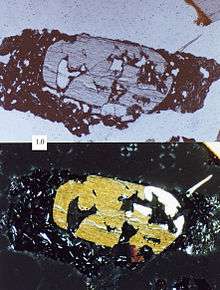Porphyritic


Porphyritic is an adjective used in geology, specifically for igneous rocks, for a rock that has a distinct difference in the size of the crystals, with at least one group of crystals obviously larger than another group.[1] Porphyritic rocks may be aphanites or extrusive, with large crystals or phenocrysts floating in a fine-grained groundmass of non-visible crystals, as in a porphyritic basalt, or phanerites or intrusive, with individual crystals of the groundmass easily distinguished with the eye, but one group of crystals clearly much bigger than the rest, as in a porphyritic granite. Most types of igneous rocks may display some degree of porphyritic texture. One main type of rock that has a porphyritic texture are porphyry, though not all porphyritic rocks are porphyries.
Formation
Porphyritic rocks are formed when a column of rising magma is cooled in two stages. In the first stage, the magma is cooled slowly deep in the crust, creating the large crystal grains, with a diameter of 2 mm or more. In the final stage, the magma is cooled rapidly at relatively shallow depth or as it erupts from a volcano, creating small grains that are usually invisible to the unaided eye.
References
- ↑ Dietrich, R. and Skinner, B., 1979, Rocks and Rock Minerals, pg. 108.